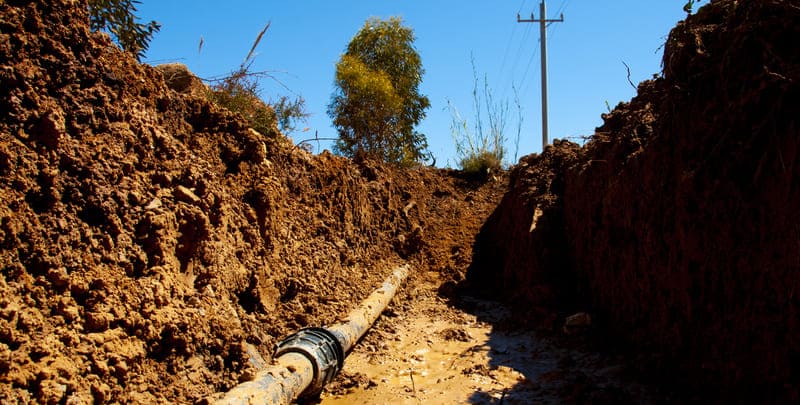
When Is Drain Excavation Necessary?
Drainage systems are the unsung heroes of our properties, quietly carrying away wastewater and rainwater to keep our homes and surroundings dry.
Proper drainage is crucial for both property and environmental health. It goes beyond just preventing puddles and clogged drains; it safeguards our foundations, prevents soil erosion, and protects against water-related damage.
When drainage systems function optimally, they go unnoticed. However, when issues arise, it becomes essential to understand when and why drain excavation may be necessary.
Understanding Drain Excavation
Home drain excavation refers to digging and exposing underground drainage systems on residential properties to address issues such as blockages, damages, or inefficiencies. Professionals, such as plumbers or excavation contractors, typically carry out this type of drainage excavation. It involves digging into the ground to access and repair or replace home drainage system components.
Common reasons for home drain line excavation include:
- persistent clogs
- sewer backups
- root infiltrations
- pipe damage
- upgrading aging infrastructure
The excavation process allows experts to visually inspect the condition of the pipes, identify the source of the problem, and implement necessary pipe relining or replacements.
The steps involved in home drain excavation may include:
- an initial assessment using tools like cameras or dye testing
- obtaining permits
- creating an excavation plan
- locating existing utilities to prevent damage
- choosing appropriate excavation techniques (manual or with heavy machinery)
- and finally, repairing or replacing damaged pipes
The drain repair is typically completed with backfilling and compaction to restore the excavated area.
The Benefits of a Drain Excavation Procedure
Embracing drain excavation brings many essential benefits for maintaining a healthy and efficient drainage system.
Firstly, it allows for the precise identification and resolution of persistent issues such as stubborn clogs, sewer backups, root infiltrations, and pipe damage. By excavating and inspecting the underground infrastructure, professionals can pinpoint the root cause of the problem, ensuring that the remedy is comprehensive and not just a temporary fix.
Moreover, drain excavation facilitates the integration of modern materials and advanced repair techniques, enhancing the longevity and resilience of the drainage system.
Tackling issues like land subsidence becomes possible through excavation, preventing further structural damage and maintaining the stability of the surrounding landscape. Furthermore, the process of backfilling and compaction, integral components of excavation, ensures that the restored area is functional and environmentally sound.
In essence, drain excavation is not merely a corrective measure; it is an investment in the longevity and efficiency of the drainage infrastructure, safeguarding properties and the environment.

Signs that Drain Excavation Might be Necessary
Persistent Clogs
Persistent clogs in drains are often the first indication that something more severe may be lurking within your drainage system. Common causes include the accumulation of grease, hair, and foreign objects in the drain bottom. While a used drain plunger or chemical drain cleaner might provide a quick fix, persistent drain clogs and multiple leaks that resist these solutions could signify a deeper issue within the pipes.
Sewer Backups
Sewer backups are inconvenient and pose severe health and environmental risks. Causes range from blockages to sewer line damage. The implications go beyond foul odours and inconvenience, as untreated sewage can contaminate water sources and harm ecosystems.
Root Infiltration
As beautiful as trees can be, they can sometimes lead to drainage problems. Moisture and nutrient-seeking tree roots can infiltrate drainage pipes and drains, causing blockages and structural damage. Signs of root infiltration and drainage issues may include slow drainage, gurgling sounds, and unexpected plant growth around sewer lines and drains.
Pipe Damage or Corrosion
Aging pipe infrastructure is susceptible to wear and tear, leading to pipe damage and corrosion. Corroded pipes compromise drainage efficiency, potentially causing leaks and even structural damage. Regular pipe inspections and repairs are crucial to identifying and addressing these issues before they escalate.
Land Subsidence
The movement of soil can impact drainage systems significantly. Land subsidence, or sinking, may occur due to geological factors or changes in soil conditions or the water table. Warning signs include uneven terrain, foundation cracks, and landscape feature shifts. Addressing drainage issues related to land subsidence is essential to prevent further damage.
What Happens During The Drain Excavation Process?
Drain excavation is a process carried out by professionals to access and repair underground drainage systems. It involves digging up the ground to expose the drain pipes for inspection, maintenance, or repair. Here is a step-by-step guide that a licensed professional will typically follow to carry out the drain excavation process from beginning to end:
- Initial assessment – Before starting the excavation, professionals thoroughly assess the drainage issue. This may involve using cameras or other diagnostic tools to identify the location and nature of the problem.
- Site preparation – Clear the area around the drain that needs excavation. This may involve removing vegetation, debris, or any obstacles hindering the process.
- Locating utilities – Identify and mark the locations of underground utilities, such as gas, water, and electrical lines. This is crucial to avoid damaging these utilities during excavation.
- Safety measures – Implement safety measures, including proper signage, barricades, and personal protective equipment (PPE) for workers. Excavation can be hazardous, and safety is a top priority.
- Excavation equipment – Select the appropriate excavation equipment based on the scope and scale of the project. Common equipment includes excavators, backhoes, or trenching machines.
- Digging the trench – Excavate a trench along the path of the drain pipes. The size of the trench will depend on the diameter of the pipes and the extent of the repair or maintenance needed.
- Exposing the pipes – Carefully dig down until the drain pipes are fully exposed. Take caution not to damage the pipes during the excavation process.
- Pipe inspection – Inspect the exposed drain pipes for damage, leaks, or blockages. If necessary, use cameras or other diagnostic tools to get a detailed view of the interior of the pipes.
- Repair or replacement – Based on the inspection findings, carry out the necessary repairs or replacements. This may involve fixing leaks, patching cracks, or replacing damaged sections of the drain pipes.
- Backfilling – Once the repairs are complete, carefully backfill the trench with the excavated soil. Ensure proper compaction to prevent settling.
- Restoration – Restore the surface area to its original condition as much as possible. This may involve reseeding grass, replanting vegetation, or repairing any hardscape features disturbed during the excavation.
- Final inspection – Conduct a final inspection to ensure the drainage system is functioning properly and the site has been restored to its pre-excavation state.
It’s essential to adhere to local regulations, obtain necessary permits, and prioritise safety to ensure a successful and compliant drain excavation. Hiring experienced professionals for this task is highly recommended to ensure the proper handling of the project.

Address Drainage Issues Now
Recognising the signs that indicate the need for drain repairs and excavation is crucial for maintaining a healthy drainage system. From persistent clogs to land subsidence, understanding these signs allows homeowners to address issues promptly. Professional assessment and drainage repair and excavation are pivotal in efficiently resolving drainage problems, ensuring that properties remain dry, foundations stay intact, and protecting the environment. As we appreciate the silent work of our drainage systems, let’s also be proactive in ensuring their continued functionality through careful safety monitoring and timely intervention when repairs are needed.
Published: 2024-01-23

















